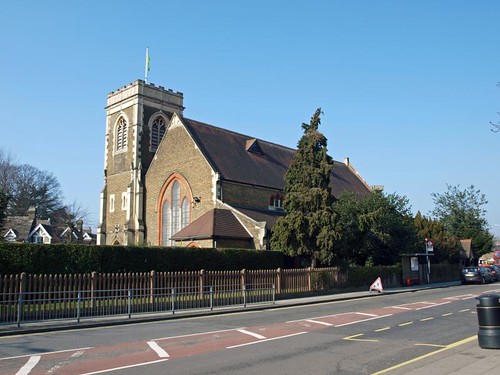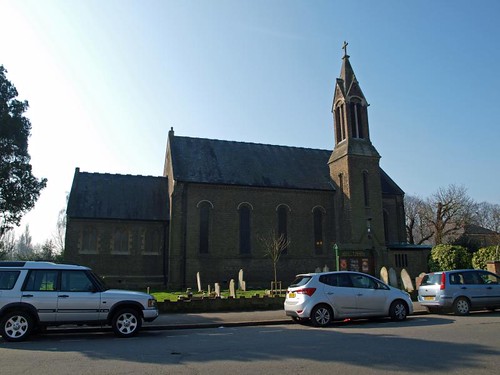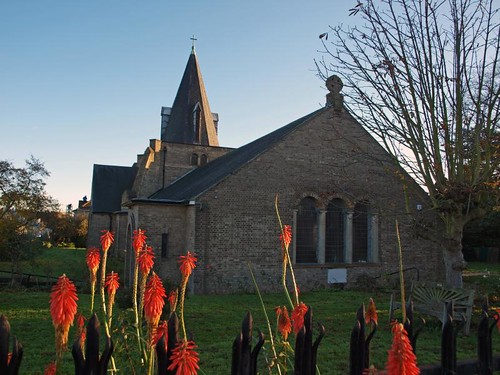DR BARNARDO'S VILLAGE HOME. Opened 1873 with about four cottages. The management of Dr Barnardo’s Homes could not supply any useful architectural information, except that the CHAPEL dates from 1892 and the AUSTRALASIAN HOSPITAL from 1912 (W. A. Pize).
HOLY TRINITY, Mossfield Green. 1840 by Blore. Norman in yellow brick, with starved tower on the N side close to the W end. Long Norman lancets, exceedingly long especially at the W end. The chancel added c. 1875.
ST GEORGE, Woodford Avenue. 1931 by Sir Charles Nicholson. Red brick with short broad square W tower with copper-covered spire. The church, low and broad, has no clcrestory and no structural division between nave and chancel. The piers are octagonal, but the E window is frankly Perp.
But this is Dr Barnardo’s village, and it is his church in the lovely park that will attract the pilgrim. The Children’s Church it is called, with room for a thousand girls, and its pinnacled tower is the guardian of their cottage homes scattered about the grounds. Here are fountains, dovecots, and old trees; fields for games; and workshops where they are trained to be good workers and good citizens. And here, under a lovely memorial designed by Sir George Frampton, lie the ashes of the founder. His portrait is on the pedestal of a mother and child, and three children are seated below. The monument is as simple and appealing as the man himself, and on it is this proud statement of his faith:
I hope to die as I have lived, in the humble but assured faith of Jesus Christ as my Saviour, my Master, and my King.
More than a hundred thousand homeless children have been snatched from the streets and given hope and life in Barnardo’s Homes, perhaps the best known philanthropy within the British Empire. We must count Thomas John Barnardo among the men who shaped the social structure of society in the progressive 19th century. He was to be a missionary in China until he took Lord Shaftesbury down to our own East End one night, and Lord Shaftesbury said to him that perhaps his duty was not to the Chinese but to these children at home.
If he did not invent kindness to children, at least he was the first great champion of children who were homeless.
A homeless child before Dr Barnardo’s day got his living as a wild animal does, hunting and fighting for it, and often stealing it. Every policeman was his enemy, and he could be brought before a magistrate for sleeping in the streets. Yet he had nowhere else to sleep. Barnardo found eleven boys sleeping on an iron roof. It was a bitter cold night, and they wore wretched rags and no underclothes. He found 70 street arabs sleeping under a tarpaulin. In doorways and empty barrels everywhere slept the most unhappy children in London.
Once Sir John Gorst visited an industrial school and saw among big brutal-looking lads a pretty baby of six. He asked what the child had done to be sent there, and learned that a policeman had caught the little one sleeping out under Covent Garden arches, and a magistrate had committed him to an industrial home for ten years. At the end of the ten years Sir John inquired for him, and afterwards wrote: “What do you think he has learned in that school? He has learned to darn stockings, and the darning of stockings is the only technical attribute which this boy has there attained! Under Dr Barnardo’s care he would have been taught a trade and put in the way of becoming a prosperous man.”
In 1894 a Departmental Committee was appointed to inquire into the case of Poor Law children. After two years the committee made recommendations of reform, and the chairman added that most of the reforms had already been put into practice by Dr Barnardo. Dr Barnardo’s Homes were a century ahead of State institutions.
This wonderful man who went to the rescue of destitute childhood was pronounced dead by two doctors when he was two years old. It was the undertaker who found that there was still a flicker of life!
The delicate baby grew into a quick-tempered boy who was often in trouble at school, but before he was 17 he grew to feel that he must give his life to the service of others.
While he was at the London Hospital, training so that he might be a medical missionary, he did some work in Ragged Schools. Learning from the stories of the homeless boys that 85 per cent of them were reduced to misery through drink, the young student went boldly preaching temperance into the vilest parts of the East End. He was assaulted; his hat was often knocked into the gutter, his spectacles smashed, his clothes torn, and once two ribs were broken. Once when a band of roughs meant to give him a thrashing they were stopped by a prize-fighter who recognised the young preacher as one of the doctors who volunteered to nurse cholera when the scourge was terrifying the East End.
Dr Barnardo began by paying a working-man to house the first homeless boy he found; then he hired a donkey stable for half-a-
crown a week to shelter more, and in a few years he had great village homes packed with children. He had once told a little boy there was no room in the Home for a few days, and a night or two afterwards the child was found dead in an alley. After that Barnardo made the famous declaration, No destitute child ever refused admission. In order to keep his vow he had to run into debt, and when he died the debt was £250,000, but it was wiped out as a tribute from a grateful country.
Dr Barnardo, founding his Home when he was still studying for his degree, continued to work like a slave all his life, seldom going to bed before three in the morning, and it is not to be wondered at that he wore his heart out at 60. “O Syrie,” he said to his wife, “my head feels so heavy,” and, dropping it on her breast, he died.
He had rescued 60,000 children. He had helped to make a new world. The whole country mourned for him, and volunteers came forward to carry on his mighty work. But during his life he had had to face scandal and lawsuits, and to battle against tremendous cares. Only a man of exceptional courage and indomitable will could have won his battle; only a man of extraordinary ability could have organised the Homes as he did. And only a saint could have loved loveless children so well that he could say “I have never seen an ugly child.”
Flickr.




No comments:
Post a Comment